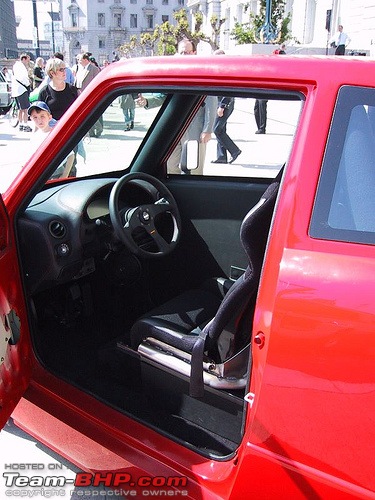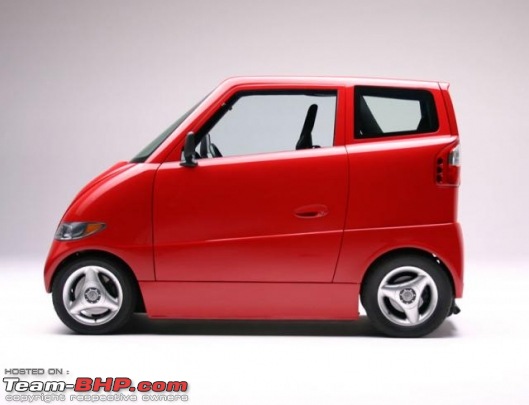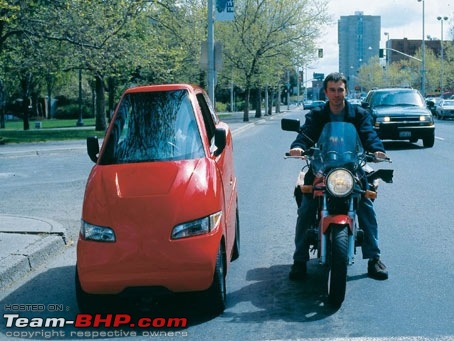The Tango is an electric car no wider than a motorcycle, with a passenger or luggage space located tandem-style behind the driver. It is so narrow that four Tangos can fit in a normal-sized parking lot. Despite its precarious looks, it has a very low centre of gravity and will stop faster, accelerate quicker and corner faster than anything else on the road. It may look vulnerable but it has a carbon fibre body shell and a race-approved roll cage structure which make it a very safe, capable and environmentally responsible vehicle.
The Tango is made by Commuter Cars Corporation, which claims it will have a lower cost of ownership per kilometre than most any four wheel conveyance. The narrow profile of the Tango offers motorcycle-like commuter car advantages in terms of parking and performance, without the vulnerability to other road users and the weather and a lack of luggage space
The rear passenger seat can be used as storage space, to carry a baby seat, or it can be removed to carry groceries or other goods. There's a lot more room back there than you'd imagine. During January's Los Angeles Auto Show, the company demonstrated how capacious the Tango's second seat is by putting a 210cm NBA basketballer in the passenger seat, and Commuter Cars Corporation's CEO Rick Woodbury in the front - both were seated comfortably.
Although the Tango could have been built with a fuel cell or internal combustion engine, the company opted for conventional lead-acid batteries which offer a 130 kilometre range (four times the distance the average commuter travels per day) and the dense weight they need located low in the car for stability. With advancements in the price-performance of high-tech batteries not far away, the company expects the range of the vehicle could exceed 300 miles per charge before long.
On top of that, with an off-board 200A charger the Tango can charge to 80% capacity in around 10 minutes on a 200 amp AC service which gives approximately 100 additional kilometres of range per quick-charge. That's not as quick as a stop at the petrol pumps but a lot cheaper, and there is an inevitability that the oil companies will offer these industrial strength outlets through the petrol station chains. A garage roof mounted, solar cell charging
module is being developed so a Tango can be charged for no cost while it is parked. Typically, Commuter Cars Corporation expects one would just plug in each night at home and get a complete charge in less than three hours and be ready for work the next morning.
Possibly a more practical solution to refueling is to use the newly removable battery pack feature. Time trials haven't been done yet, but as it stands you should be able to swap a battery pack in under 10 minutes. With some added automation, Prodrive engineers believe it could be done in less than a minute.
This opens the door to quicker refueling than a typical car. The use of 300-mile range Li-Ion packs will make it actually more convenient than a petrol car once the infrastructure is in place. Meanwhile, for the commuter, the car works perfectly without any need for infrastructure. It's by nature not a family car but it does commuting to work or shopping more conveniently we believe than any car in history.
Okay, that's the responsible citizen justification but just as many people are expected to buy the Tango for its sporting prowess as its eco-friendly benefits. This tiny road-dwelling creature accelerates, handles and stops like a motorcycle but drives like a car.
In a very lightweight body, electric motors can deliver their characteristic torque low in the rev range for amazing low speed acceleration.
With a 9" electric motor driving each rear wheel and over 1,000 ft-lb of combined torque at low rpms, the Tango can accelerate from zero to 150 mph in one gear. It accelerates from zero to 60 mph in four seconds, which makes
it faster than most exotica you can buy off the showroom floor such as the Dodge Viper, Porsche Carrera GT or Ferrari F50 and twice as quick over a short distance as most road inhabitants. It will also stop the clocks at 12 seconds dead for a quarter mile so at all legal road-going speeds, the Tango reigns supreme over all four wheelers though it falls short of the fastest sports motorcycles.
As the Tango is electric, it has some drawbacks, the most obvious being its range but most commuter trips are within the range of an electric Tango and the company is now accepting fully refundable orders for its first three models.
The first available Tango will be the high-performance, luxury Tango 600, which is available now as a mostly-assembled kit requiring less than a day to complete. The Tango is not cheap at US$85,000 so it's not for the less-enthusiastic early adopter but it does come with a luxury kit that places it on paper at least, in luxury car territory.
At that price you get a carbon fibre body, Connolly leather interior, Sparco seats, climate control, a Momo steering wheel, a MoTeC dash and a 400-Watt sound system.
The car will become viable for most of us in its subsequent versions with lesser performance but all-wheel drive via four 50 kilowatt hub motors. The fiberglass-bodied Tango 200 will sell for a far more civilized AUS$40,000 and a subsequent Tango 100 model will sell for US$18,700 and lesser performance again. Writeup ( copy paste ) source is
this 





Specifications:
Width: 39" (5" narrower than a Honda Gold Wing)
Length: 8'5" long, allowing it to park perpendicular to the curb.
Height: 60"
Ground Clearance: 4"
Weight: 3,150 lbs.
Distribution: 43/57 (percent front/rear)
Batteries:
19 Hawker Genesis G70EP lead acid batteries. Li-Ion batteries are optional.
Nominal Voltage:
228 V with 19 Hawkers (350 V with Li-Ion batteries)
Battery Weight:
988 lbs. (Hawker)
Charging:
40 amp on-board charger with Avcon conductive coupling.
(200 amp off-board charger under development.)
Steering:
Rack and pinion with Cadillac CTS collapsible steering column and Momo Corse steering wheel
Front Suspension:
Unequal length A-arm with coil-over Carrera shocks.
Rear Suspension:
Trailing arm with coil-over Carrera shocks.
Controller:
Zilla Z2K motor controller, providing up to 2,000 Amps at 350 Volts (600 kW).
Designed and built by Otmar Ebenhoech at Café Electric LLC in Corvalis, OR.
Motors:
2 Advanced DC FB1-4001 9" motors, one driving each rear wheel with over 1,000 ft-lb of combined torque at low rpms. 8,000 rpm redline.
Transmission:
2 direct drive gear boxes designed by Bert Transmission of St-Constant, Québec, the leading manufacturer of dirt circle track race car transmissions. 10 available ratios from 2.92:1 to 5:1. Standard ratio is 3.86:1. Splined axles can be easily locked together with center sleeve.
Hubs/Wheel Bearings:
As used on the Mazda Miata.
Wheels:
König alloy wheels: 14 x 6 front/15 x 6.5 rear, 4-100 bolt pattern
Tires:
Toyo Proxes T1R: 195/45R14 front; 215/45R15 rear
Brakes:
Mazda Miata calipers with Hawk HP Plus (rear) and HPS (front) pads. Wilwood master cylinder and pedal assembly.
HVAC:
12,000 BTU Vintage Air air conditioning system driven by variable speed AC motor for predictable climate control. 3,000 W electric heater for instant-on, powerful heating.
Seating:
Tandem Sparco custom bucket seats with 4-point aircraft pilot harnesses on attached structures. Passenger straddles the front seat and harness structures which do not interfere with the passenger's knees.
Storage:
Passenger and a few bags of groceries with rear seat installed.
Removed, it allows 2 very large suitcases and a large briefcase with the driver's seat in extended position. (Rear seat with harness structure is removable through rear hatch.) Multiple compartments for smaller items.
Headroom:
39" driver and passenger.
Trailer Hitch:
Accepts standard 1.25" hitch for towing generator cart for extended range. Front hitch for moving small airplanes.
Note: Projected performance specifications will vary depending on final weight, gearing, tires, and batteries used. Acceleration figures assume racing slicks are used on a drag strip.
Range:
40-60 miles maximum with Lead-Acid batteries.
Over 150 miles with Li-Ion batteries
Cost per Mile:
About 1/2 the cost of a gasoline car for the average commuter.
Acceleration:
0 to 60 MPH, about 4 seconds.
1/4 mile time about 12 seconds at a speed of approx. 120 MPH
Top Speed:
135 MPH
Source :
http://www.commutercars.com
@Mods : I could not find information on this car hence created a new thread, if there is already a thread on this please merge it.












 and 120 in 12 seconds.
and 120 in 12 seconds.

